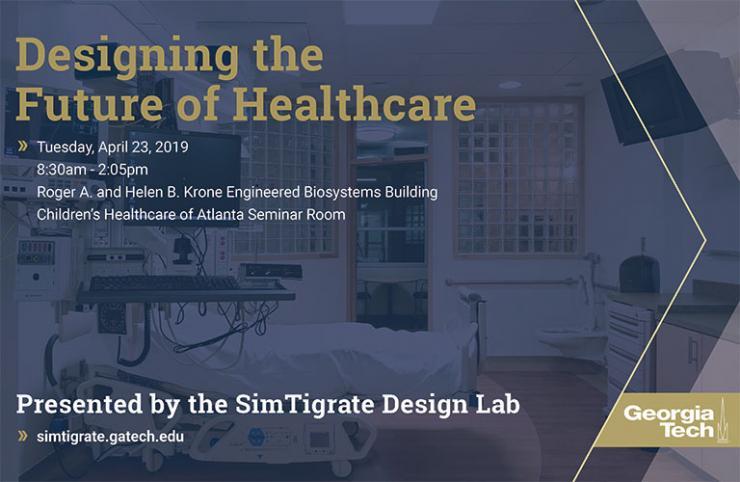SimTigrate Researchers and Alumni Are Designing the Future of Healthcare
Apr 16, 2019 — Atlanta, GA

Several Georgia Tech alumni will bring their expertise to a symposium put on by the SimTigrate Design Lab.
The symposium will feature leading researchers and designers – alumni trained at the SimTigrate Design Lab in the College of Design, as well as current researchers and students – and will look at the ways design and the design process can transform healthcare.
The symposium, titled Designing the Future of Healthcare: Linking Problem, Evidence, and Transformation, will feature a keynote from SimTigrate Director and School of Architecture Professor Craig Zimring.
He expects the symposium “will identify emerging problems facing healthcare. In the late 20th century we realized the harms we do to patients inadvertently through errors and infections. That, combined with the opportunities to build tens of billions of dollars in healthcare facilities, led to evidence showing that design can address problems in safety and errors. The field of evidence-based design has helped improve the experience of millions of patients worldwide by supporting safer, quieter, light-filled, better organized facilities.”
The symposium also will show how healthcare design research and innovative design of primary and in-patient care can help healthcare organizations address their biggest pressures, which include cost and reimbursement, patient and staff safety, patient experience, and chronic disease.
The result will be a view of emerging themes in healthcare design and research and a map of how researchers and designers can be full partners in transformation, Zimring said.
Looking Toward the Future
He said healthcare systems are also facing the problem of the coming tsunami of chronic diseases, as care providers deal with things like diabetes, heart disease, cancer, and depression.
Zimring said the issue now is to identify the problems that are addressable through physical design and technology. Let’s look at evidence and research that our alumni and lab have done that shows that design can address problems of safety, efficiencies, staff processes, and more, he said.
Looking ahead, Zimring said that for the future of healthcare we must create a system which is more efficient, and which keeps people well rather than just curing them when they are sick.
The way forward, he said, is to bring together built environment technology and improvements in process and access in some integrated way, making the built environment part of the fundamental tool kit in providing health care.
Alumni Bring Their Expertise
Alumni in academia and industry will join current SimTigrate students and researchers. Many continue to do research at their universities, lead research centers of their own, and work with researchers in industry.
One of the returning alumni is Joshua Crews (M.Arch 2011), a senior architect and healthcare team leader at Nelson, an architecture firm with an office in Atlanta.
He is expected to talk about the role of research in the design process, and show how researchers and industry work together.
He and his firm are working with Georgia Tech and Emory University to create a facility to support a living laboratory for those diagnosed with mild cognitive impairment. With little existing evidence to draw from, his work will rely on research to inform design decisions, program activities, and more. He will give some insight into the process.
Crews also presents and continues to do research with Jennifer DuBose, SimTigrate associate director.
DuBose and SimTigrate researchers have built a Lighting User Experience or L(ux) Lab with funding from the Pacific Northwest National Lab and fully tunable white lights donated by Signify.
New developments in lighting technology and discoveries about how light impacts the human brain have led to many opportunities to enhance the experience in healthcare environments. Building on literature reviews with the help of SimTigrate alumni and current students, the lab has designed a series of lighting experiments to evaluate the performance, acceptability and impact on behavior of different lighting conditions with a range of spectral properties and intensities.
The findings from the completed experiments on the acceptability of lighting for nursing tasks will be shared.
The presentation also will include a first look at the plans for testing the use of lighting to enhance cognitive performance in the collaboration between Emory and Georgia Tech in the Mild Cognitive Impairment Empowerment Center in Executive Park in Northeast Atlanta.
Zimring notes that one advantage of working with industry is it gives them the chance to implement their work quickly into the real world.
In bringing back former students, Zimring said one idea was to highlight the achievements of Georgia Tech in the area of healthcare design research and of the many former students around the country.
SimTigrate has helped nurture some of the most effective people in the field and they in turn are training students and engaging the world. “We are celebrating our impact,” he said.
Returning alumni and their current places of employment are:
- Sheila Bosch, Ph.D. Arch 2004, University of Florida
- Hui Cai, Ph.D. Arch 2012, University of Kansas
- Josh Crews, M.Arch 2011, Nelson Architects
- Saif Haq, Ph.D. Arch 2001, Texas Tech University
- Anjali Joseph, Ph.D. Arch 2006, Clemson University
- Lisa Lim, Ph.D. Arch 2018, Texas Tech University
- Lorissa MacAllister, Ph.D. Arch 2015, Enviah
- Michelle Ossmann, Ph.D. Arch 2016, Steelcase
- Debajyoti Pati, Ph.D. Arch 2005, Texas Tech University
Current researchers and students are:
- Jennifer DuBose, Associate Director of the SimTigrate Design Lab
- Zorana Matic, Graduate research assistant at SimTigrate and Ph.D. student
- Raha Rastegar, Graduate research assistant at SimTigrate and Ph.D. student
- Craig Zimring, Director of the SimTigrate Design Lab
This symposium is supported by a grant from the College of Design’s Associate Dean for Research, Nancey Green Leigh.

Malrey Head
Digital Communications Specialist




